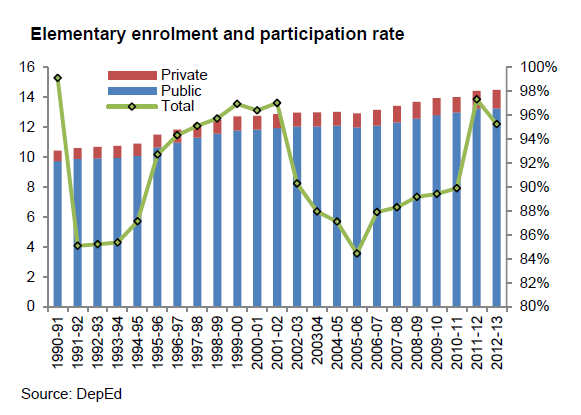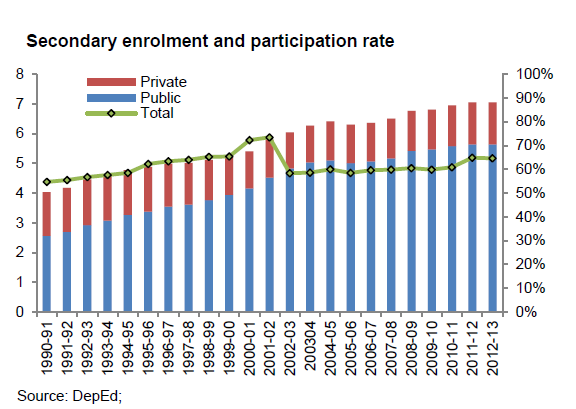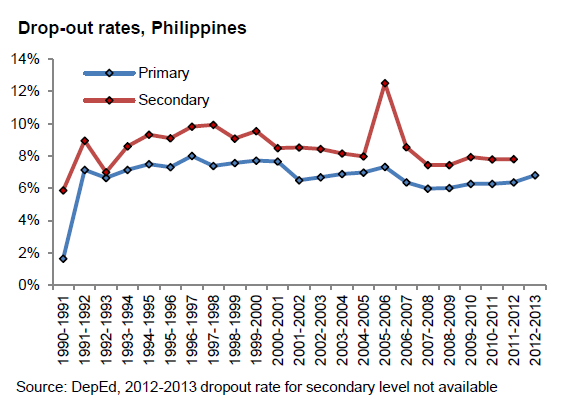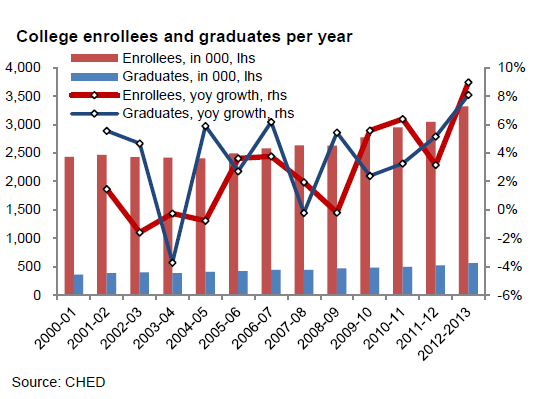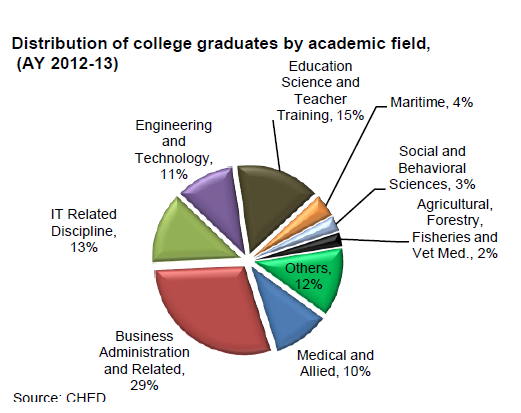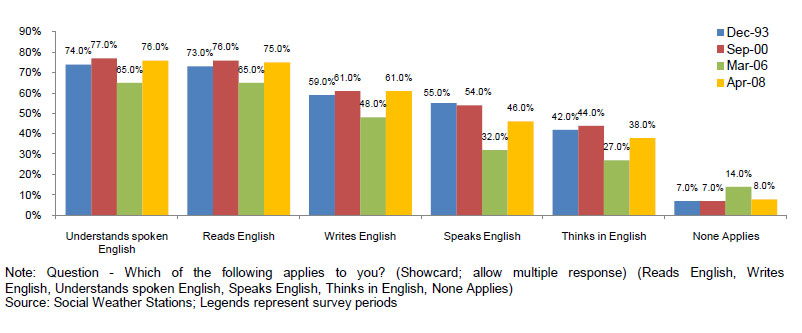Education
Education in the Philippines is inadequately robust to support high economic growth and needs extensive reform including greatly increased resources. All levels of education in the Philippines have deteriorated over several decades, faced with an increasing young population that has outstripped available resources. Yet rapid economic progress, attracting high levels of investment, and moving into knowledge-based services, require a well-educated workforce with appropriate skills for a middle income economy. Maintaining and improving national competitiveness also requires much improved education.
Having a large pool of skilled manpower is an attraction to foreign direct investments, which in turn improves economic activity. Policy makers should focus on enhancing the country’s competitive edge by improving its educational system.
The WEF Global Competitiveness Report ranks the quality of the education systems of 139 countries. The Philippines ranked 69th, just behind Thailand and Vietnam, but is declining and will remain the lowest rated in the ASEAN-6 if it does not pursue strong educational reform (see Figure 238).
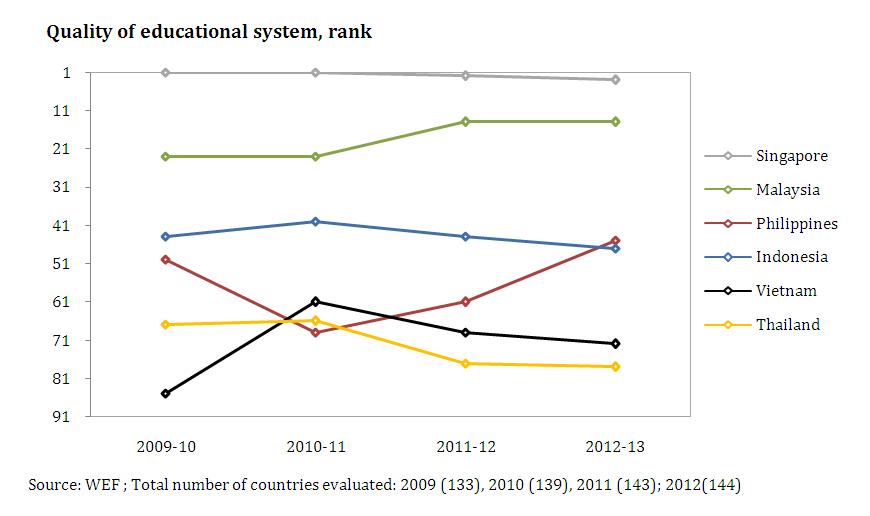
View original figure here
The national government spends only 2.5% of GDP on education, less than Malaysia, Thailand, and Singapore (but more than Indonesia) while the East Asian average was 3.6% in 2005 (see Figure 239). The education budget proposed for 2011 totals PhP 207 billion, an 18.5 percent increase, which will include building 18,000 more classrooms, buying 32 million textbooks, and hiring 10,000 more teachers.
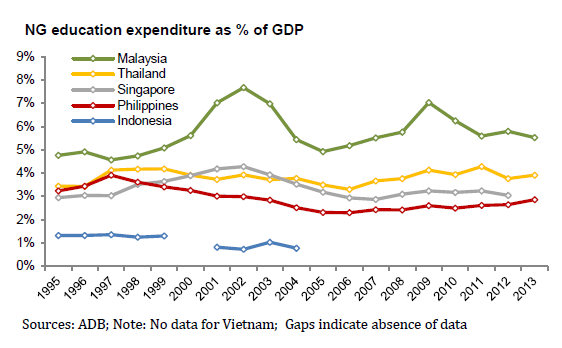
View original figure here
Of the ASEAN-6 the Philippine government spends the least per student (see Table 84). The amounts are shockingly low, with Malaysia, Thailand and Vietnam spending more than twice as much and Indonesia 65% more. With so little public sector investment in education, the poor performance of graduates should come as no surprise.

View original table here
Over 20 million Philippine children are enrolled in basic (elementary and secondary) education (see Figures 240 and 241). Elementary school lasts for six years and secondary for four. In the American colonial period, elementary was for seven and secondary was for four.
The 10-year total for basic education is the shortest in the Asian region, which follows a 12- year basic education system, followed by four years of college. In the Philippines, high school and college graduates are in school for two years less than their counterparts elsewhere and graduate at 16 often inadequately prepared and too young for fulltime employment. Because their first year in college is often used to repeat their high school curriculum, colleges are increasingly adding a fifth year, which adds to the financial burden on families.
High-drop out rates of 6% for elementary and almost 8% for secondary mean many students do not complete their education and do not acquire skills needed for jobs in a modern middle-income economy (see Figure 242). From 1,000 students who begin schooling at Grade 1, only 650 complete elementary school. Of these, only 430 graduate from high school, and 230 enter college, but only 120 will get a degree (12% of the number who started).245 Most who drop out are among the poorest and cannot afford the costs associated even with free basic education and college. Like their parents, the drop-outs are destined for low-skill jobs and unemployment, repeating the cycle of a life of poverty.
Classrooms in basic education in the Philippines are very over-crowded. The pupil-teacher ratio is higher than most Asian countries and has been increasing (see Table 85). By contrast, elsewhere in Asia, the ratio has been declining. In Philippine primary schools in 2008, the ratio was 33.7 and in secondary schools it was 35.1. Both were the highest of the ten countries included in Table 85. The combination of less attention from teachers and a shorter basic education cycle means Philippine students are likely to be less well-educated than students in other Asian countries, where students study longer and receive more attention from teachers.
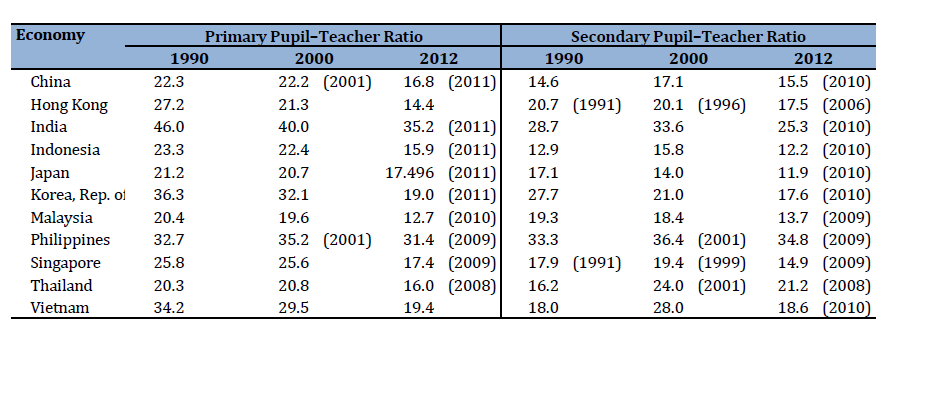
View original table here
View related figure here
The number of students declines considerably at the tertiary level, where the total enrollment of 2,700,000 is only about 40% of the total number of secondary students. Only a half million students are forecasted to receive their college degrees in 2011 (see Figure 243).
The WEF rating for quality of math and science education ranks the Philippines as 112th of 139 countries, far behind Thailand (57th) and Singapore (1) (see Figure 245).
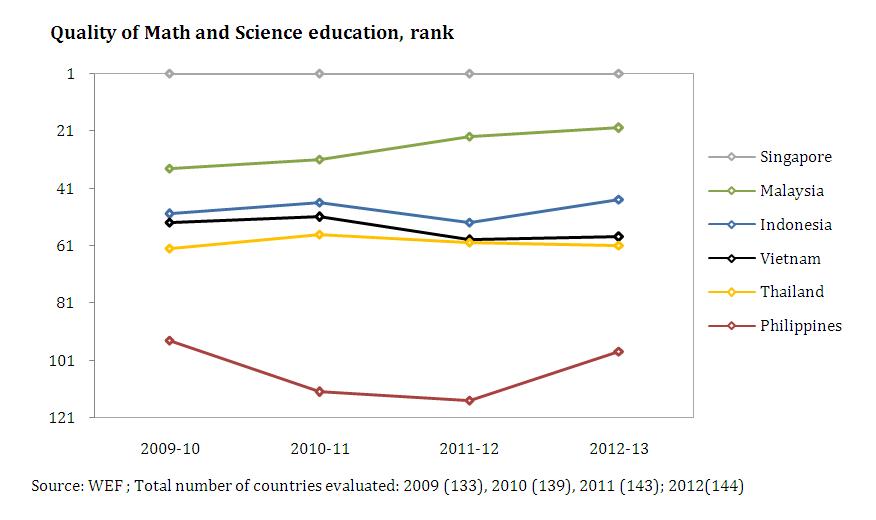
View original figure here
The Philippines is moving too slowly to reform it educational system and should accelerate reforms as soon as possible. Budgetary restraints in 2010 are holding it back. By contrast, over the last decade China has nearly tripled the share of its fast-growing GDP devoted to education. (In the Philippines the opposite happened as the GDP share declined). China has doubled the number of colleges and quintupled the number of college students to 5.5 million in 2007. China has identified its nine top universities and singled them out as its version of the Ivy League. Chinese colleges have relationships with more than 700 foreign universities. Yale president Richard Levin observed, “This expansion in capacity is without precedent. China has built the largest higher-education sector in the world in merely a decade’s time.”246
With a debatable claim to be the world’s third-largest English speaking country, the Philippines cannot afford to lose one of its main competitive advantages, its large English-speaking workforce.247 The only reliable survey of the extent of English language skills is a series of SWS polls taken in 1993, 2000, 2006, and 2008 in which respondents were asked to self-assess their ability to understand, read, write, speak, and think in English. In 2006 only 32% responded that they could speak, but this rose to 46% in 2008 for reasons that were not researched (see Figure 246).
Philippine leaders have acknowledged the deterioration of spoken English among younger Filipinos and the importance of reversing this trend to maintain international competitiveness (see Part 3 BPO). Based on data from public schools for the school year 2003-04, for every 1,000 entrants to Grade 1 only seven graduated Grade 6 with sufficient mastery in English, math, and science required to succeed in high school and college.
Former president Macapagal-Arroyo realized the English skills of basic education and many college graduates were inadequate, especially for employment in the BPO sector. In January 2003 she restored English as a primary medium of instruction in public schools. The Department of Education (DepEd) has subsequently sought to improve the English skills of teachers, but its success has not been measured with international testing. More can be done, especially using computerized training software.
The base of English speakers in the Philippines remains sizeable. Most students know some English but need more opportunities to listen to and speak English. Philippine radio and television media predominantly use Filipino, while 30 years ago more of their broadcasts were in English.
“In Bangalore, knowing English is equal to having food. If you don’t have English you can’t survive your job.”
—Rajeev Chamoli, sogtware programmer, quoted in India’s Aspiring English Speakers, AWSJ, March 3, 2010
Headline Recommendations
- Increase public education budget over several years to at least PhP 400 billion (3.5-4% of GDP) for better classrooms, more and better teachers quality, and reduced teacher/student ratio. Double average spending per student to ASEAN-6 average. Adopt K+12 model to extend basic education by two years and add a pre-elementary year.
- Constantly improve teacher quality and curriculum to produce graduates with skills required for higher quality jobs. Apply competency-based standards, more in-service training, maintain teacher welfare and morale. Increase study of math and science, technical/vocational skills training. Encourage college/post-graduate study in fields needed for specialized positions, including foreign languages. Intensify investment in technology for high school education to connect all 6,786 schools to Internet. Equip high school teachers with notebook computers and students with e-readers. Establish computerized English language centers in high schools.
- Strengthen higher education by providing more resources for world class centers of excellence. Expand scholarships/loans for higher education. Encourage more accredited foreign schools and foreign teachers. Undertake a vigorous public campaign to emphasize English language competency. Strengthen the Dual Education/Dual Technical System. Expand the internship period to prepare students better for employment.
Recommendations (12)
A. Commit to a large increase in the public education budget over several years to at least PhP 400 billion and 3.5-4% of GDP to build, repair, and equip new and old classrooms, eliminate the teacher shortage, raise teacher salaries, and reduce the teacher/student ratio. Double the average spending per student to be closer to other ASEAN economies. (Long-term action DepEd, DBM, NEDA, and Congress)
B. Over a period of several years, extend basic education by two years and add one year before elementary school (the K+12 model). Students should graduate high school at age 18 prepared either to enter the workforce or college. Increase technical/vocational skills training in the high school curriculum. (Long-term action DepEd, DBM, and NEDA)
C. Empower teachers by constantly improving their quality and their curriculum to help students acquire the knowledge and skills required to enable them to get higher quality jobs. Apply competency-based standards for teachers and provide more in-service training, while maintaining their welfare and morale. (Medium term action DepEd and CHED)
D. Basic education and college curricula should be adjusted to increase the study of math and science. Encourage more college students to study fields needed for specialized positions in the economy (e.g. agribusiness, computer science, engineering, environmental science, mining, and physics). Teach more foreign languages in colleges to support the BPO and tourism sectors. (Medium-term action (DepEd, CHED, DOLE, DTI, NEDA, and private sector)
E. Intensify investment in technology for high school education. Complete the private sector Gearing Up Internet Literacy and Access for Students (GILAS) program to connect high schools to the Internet (of 6,786 high schools, 3,892 remain to be connected). Equip high school teachers with notebook computers and students with e-readers. Place more computers in high schools using grants, donations, and purchases. (Long-term action DepEd, DBM, NEDA, and private sector)
F. Strengthen higher education by providing more resources for world class centers of excellence and expanding scholarships and loans for higher education, while reducing national government subsidies for low quality state and local universities/colleges. Make government student loans available through SSS, GSIS or banks to be repaid after employment for tertiary and technical/vocational education students to enroll in accredited public and private higher education institutions. (Medium-term action CHED, SSS, GSIS, and private sector)
G. Encourage qualified foreign schools to operate and foreigners to teach in the Philippines. Solutions to the educational deficit should include foreign as well as domestic resources. (Immediate action DTI, CHED, DOLE, and private sector)
H. Install English language computer training labs in high schools, supplementing teacher resources with English training software. Each lab should have ten computers. The private sector can donate large numbers of used computers, while the government can purchase the software and handle logistics. (Long-term action DepEd, LGUs, and private sector)
I. To advance bilingualism, undertake a vigorous public campaign to emphasize the importance of English competency to entering and existing workforce members. Such a campaign should point out that mastery of English enables access to global knowledge and wider economic opportunities. Encourage television and radio stations to use more English in their programs. (Immediate action OP, DepEd, NEDA, and private sector)
J. Recognize high schools and tertiary schools and students who score well on English tests. Schools should be assessed for their capacity to deliver quality English-language instruction given quality scores based on test results of their graduates. (Immediate action DepEd and private sector)
K. Strengthen the Dual Education/Dual Technical System by expanding scholarships and involving the private sector in curriculum development and internships. (Immediate action DOLE and TESDA)
L. Universities and Colleges should allow students in the second half of their studies to spend longer periods in companies (expand the internship period) to prepare them better for employment. (Immediate action CHED and private sector)
Footnotes











